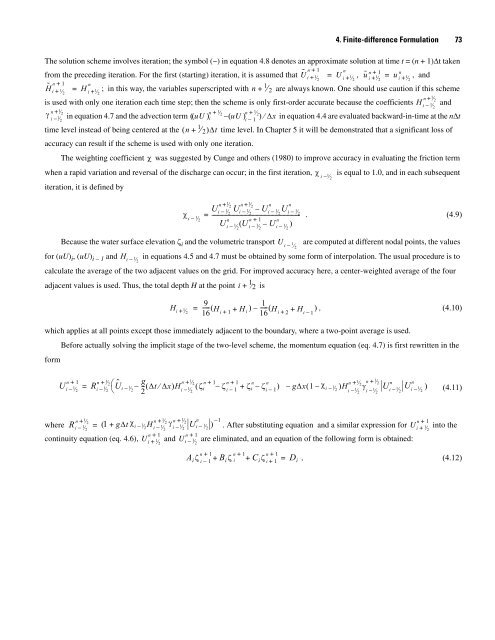A Semi-Implicit, Three-Dimensional Model for Estuarine ... - USGS
A Semi-Implicit, Three-Dimensional Model for Estuarine ... - USGS
A Semi-Implicit, Three-Dimensional Model for Estuarine ... - USGS
You also want an ePaper? Increase the reach of your titles
YUMPU automatically turns print PDFs into web optimized ePapers that Google loves.
4. Finite-difference Formulation 73<br />
The solution scheme involves iteration; the symbol (~) in equation 4.8 denotes an approximate solution at time t = (n + 1)Δt taken<br />
n + 1 n n + 1 n<br />
from the preceding iteration. For the first (starting) iteration, it is assumed that Ũ i + 1⁄ = U<br />
2 i + 1⁄ , ũ<br />
2 i + 1⁄ = u<br />
2 i + 1⁄ , and<br />
2<br />
H˜ n + 1 n<br />
1<br />
i + 1⁄ = H<br />
2 i + 1⁄ ; in this way, the variables superscripted with n + ⁄ 2 are always known. One should use caution if this scheme<br />
2<br />
n + 1⁄ 2<br />
is used with only one iteration each time step; then the scheme is only first-order accurate because the coefficients H i – 1⁄ and<br />
2<br />
n + 1<br />
γ ⁄ 2<br />
n + 1⁄ 2 n + 1⁄ 2<br />
i – 1⁄ in equation 4.7 and the advection term ( uU )i – ( uU ) 2<br />
i – 1 ) ⁄ Δxin<br />
equation 4.4 are evaluated backward-in-time at the nΔt<br />
1<br />
time level instead of being centered at the ( n + ⁄ 2)Δt<br />
time level. In Chapter 5 it will be demonstrated that a significant loss of<br />
accuracy can result if the scheme is used with only one iteration.<br />
The weighting coefficient χ was suggested by Cunge and others (1980) to improve accuracy in evaluating the friction term<br />
when a rapid variation and reversal of the discharge can occur; in the first iteration, χ i – 1 is equal to 1.0, and in each subsequent<br />
⁄ 2<br />
iteration, it is defined by<br />
χ i – 1⁄ 2<br />
n + 1⁄ 2 n + 1⁄ 2 n n<br />
Ui – 1 Ui ⁄ 1<br />
2 – ⁄ – U 2 i – 1⁄ U 2 i – 1⁄ 2<br />
----------------------------------------------------------------n<br />
n + 1 n<br />
U i – 1⁄ ( U 2 i – 1⁄ – U 2 i – 1⁄ )<br />
2<br />
= . (4.9)<br />
Because the water surface elevation ζi and the volumetric transport U i – are computed at different nodal points, the values<br />
1<br />
⁄ 2<br />
<strong>for</strong> (uU) i, (uU) i − 1 and Hi – 1⁄ in equations 4.5 and 4.7 must be obtained by some <strong>for</strong>m of interpolation. The usual procedure is to<br />
2<br />
calculate the average of the two adjacent values on the grid. For improved accuracy here, a center-weighted average of the four<br />
adjacent values is used. Thus, the total depth H at the point i<br />
Hi + 1⁄ 2<br />
+<br />
1<br />
⁄ 2 is<br />
9<br />
1<br />
= ----- ( H<br />
16 i + 1 + H ) – ----- ( i H<br />
16 i + + H ) , (4.10)<br />
2 i – 1<br />
which applies at all points except those immediately adjacent to the boundary, where a two-point average is used.<br />
<strong>for</strong>m<br />
Be<strong>for</strong>e actually solving the implicit stage of the two-level scheme, the momentum equation (eq. 4.7) is first rewritten in the<br />
+<br />
n 1<br />
U i – 1⁄ 2<br />
n + 1⁄ 2 g<br />
n + 1⁄ 2 n + 1 n + 1 n n<br />
n<br />
Ri – 1 Ûi 1<br />
⁄ 2 – ⁄ – -- ( Δt ⁄ Δx)<br />
H 2<br />
i 1<br />
2<br />
– ⁄ ( ζi – ζ<br />
2<br />
i – 1 + ζi – ζi<br />
– 1)<br />
gΔx 1 χ + 1⁄ n + 1⁄ 2 2 n n<br />
= ⎛<br />
– ( – i – 1⁄ )Hγi Ui<br />
2 i – 1⁄ 1 1 Ui 1<br />
2 – ⁄ – 2 ⁄ 2 – ⁄ )<br />
⎝<br />
2 (4.11)<br />
–<br />
n + 1⁄ 2<br />
n<br />
where R i – 1⁄ 1 gΔt χ + 1⁄ 2 n<br />
+ i – 1⁄ H γ + 1⁄ 2<br />
n<br />
(<br />
2<br />
2 i – 1⁄ 2 i – 1⁄ Ui 1<br />
2 – ⁄ ) 2<br />
1<br />
n 1<br />
= . After substituting equation and a similar expression <strong>for</strong> U i + 1⁄ 2<br />
n + 1<br />
n + 1<br />
continuity equation (eq. 4.6), U i + 1⁄ and Ui 1<br />
2 – ⁄ are eliminated, and an equation of the following <strong>for</strong>m is obtained:<br />
2<br />
+ into the<br />
n + 1 n + 1 n + 1<br />
Ai ζ i – 1 + Bi ζ i + Ci ζ i + 1 = Di , (4.12)

















